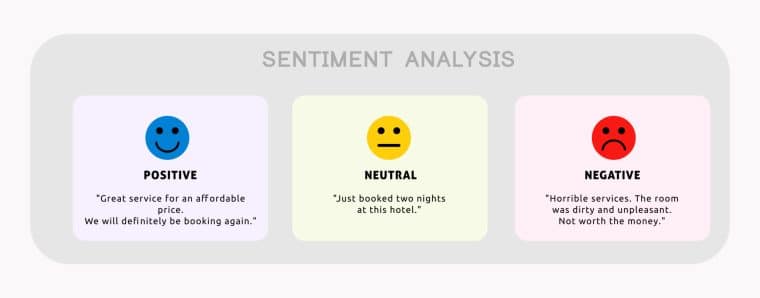Discourse analysis serves as a powerful tool for businesses to provide insights into the underlying messages and trends within business communication that impact your decision-making and strategy formulation. By decoding the complexities of language use in various contexts, decision-makers can better understand market movements, customer behaviors, and competitive dynamics.
In this guide from our experts at Business2Community, we will take you through the essentials of conducting effective discourse analysis, from the foundational steps to practical application, with relevant examples to guide your process. Our aim is to equip you with the knowledge and tools to apply discourse analysis in your strategic endeavors.
Discourse Analysis – Key Takeaways
- Discourse analysis provides a framework for examining how language and communication affect social practices, identities, and power dynamics within specific contexts.
- Employing discourse analysis as a methodological tool can enhance understanding of the implicit meanings and societal implications behind spoken or written texts.
- Regular running discourse analysis encourages critical thinking and reflexivity, fostering an awareness of how discourse shapes, and is shaped by, social structures and cultural norms.
What is Discourse Analysis?
Discourse analysis is a research method used in linguistics to study written or spoken language in relation to its social context. It aims to understand how language is used in real-life situations and the purposes it serves. In a business context, you can use it to better understand what your customers are saying about your brand.
Discourse analysis elucidates the intricacies of language, examining how choices in phrasing, narrative structure, and rhetoric can influence perceptions and behavior. Analyzing discourse can uncover the subtle layers of meaning that contribute to the larger social and cultural constructs, such as how your target audience responds to your social media posts.
Who Needs to Do a Discourse Analysis?
- Business owners can use discourse analysis to understand consumer behavior and improve their marketing strategies.
- Stock traders and financial analysts may employ discourse analysis to examine the language used in financial reports and statements for market insights.
- Marketing professionals and public relations experts apply discourse analysis to craft compelling narratives and messages that resonate with audiences.
- Social media managers and content creators use discourse analysis to tailor content to their target audience and engage with them meaningfully.
How to Perform a Discourse Analysis
Performing discourse analysis involves a series of systematic steps to unpack the complexity of communication. Below is a simplified guide to conduct a basic discourse analysis.
Step 1: Define Your Research Question
Before diving into the analysis, clearly define what you want to learn from the discourse — be it an exploration of language used in customer feedback, the rhetoric strategies in company announcements, or the persuasive elements in advertising copy.
Here are some examples of research questions for discourse analysis:
- How does the language in customer testimonials reflect the brand’s identity and influence potential customers?
- What linguistic patterns in CEO letters and earnings call transcripts can predict stock price movements?
- Which discourse strategies on social media platforms enhance user engagement and foster community building?
Step 2: Collect Data
Gather the text or transcripts that are relevant to your research question. This could be a corpus of social media posts, reviews from ecommerce platforms, a series of press releases, written or oral language, or recorded speech, depending on your focus.
Step 3: Define the Context
No discourse is created in a vacuum. The context within which communication takes place affects its interpretation. Consider different contextual factors, such as:
- Social, political, and cultural climate
- Historical background
- Power dynamics and social hierarchies
- Participants’ identities and backgrounds
You need to understand why the discourse has been created, for example if online reviews have been submitted spontaneously or by invite or if press releases have been created as part of a planned campaign or as damage control following a scandal.
Step 4: Identify Discursive Features
Begin by identifying linguistic features that are significant for your analysis. Look for patterns and peculiarities in the language that could reflect underlying ideas or ideologies.
This list outlines the various levels of rhetorical analysis at which discourse analysis examines communication to uncover deeper meanings and social implications:
- Lexicon: Analyzing words and phrases for their ideological undertones, levels of formality, and their use in metaphors and euphemisms.
- Syntax: Investigating sentence structures — such as verb tenses, voice (active or passive), and the deployment of questions and commands — to discern underlying messages.
- Structure: Examining how the arrangement of text influences emphasis and narrative development.
- Genre: Assessing texts based on genre-specific conventions and aims, such as in political discourses or media reporting.
- Non-verbal cues: Considering non-verbal elements, like vocal tone, pauses, and physical gestures, to interpret a speaker’s true intentions and feelings.
- Interaction patterns: Analyzing conversational dynamics, including how turns are taken, interruptions, and responses, to understand cultural norms and social hierarchy.
Step 5: Code Your Data
Assign codes to sections of the text that represent certain themes or concepts as they relate to your research question. This could involve numbers, color-coding text segments, or using software for thematic coding. This can be as simple as taking a highlighter to printed texts to more complex ways to categorize Reels or focus groups.
Step 6: Analyze Patterns and Themes
Examine the occurrences and contexts of your codes across the data set. Consider how these patterns may relate to your research question and the broader discourse being analyzed. Look for trends, exceptions, and notable examples that might support or challenge your initial understanding.
You might be looking for slang to see how people relate to your content creators, neutral adjectives in a seemingly positive review, or comparisons to products you weren’t aware of as competitors, for example.
Step 7: Draw Conclusions and Apply Insights
Finally, synthesize your findings to draw conclusions. How do they answer your research question? How can these insights be applied to improve business practices and communication strategies, or to understand market sentiment better?
You may want to mirror the blog tone of a company you admire and update your brand guidelines, or you may want to target a new market based on what surfaces from online reviews, as an example.
In-Depth Example of Discourse Analysis
Let’s delve into an example of discourse analysis with a focus on the cryptocurrency market. In this scenario, a fintech startup focused on cryptocurrency analytics is using discourse analysis to predict market trends by examining the impact of social media.
First, the company needs to define its research question.
It wants to know how the language used by influential figures on social media platforms like X affects the price volatility of a specific cryptocurrency, such as Bitcoin.

The person conducting the analysis now needs to collect data. They decide to compile a dataset of posts from X (formerly Twitter) published by prominent cryptocurrency advocates over a one-month period, numbering around 500 posts.
Defining the context, they decide that the broader context is the highly volatile nature of the cryptocurrency market, with Bitcoin as a notable case study. Other relevant contextual factors could include global political events, regulatory changes, and media coverage.
In this example, a post from Elon Musk on X about Tesla’s suspension of Bitcoin payments could serve as an external contextual influence.
When identifying the discursive features, the analyst looks for elements such as:
- Lexicon: Examining how words like “bullish” or “bearish” are used to convey market sentiment and expectations.
- Syntax: Looking at how sentence structures can influence the perceived certainty or ambiguity of a statement, particularly in predicting future price movements.
- Structure: Analyzing the placement and framing of key terms or phrases within a post, such as “hodl”, “moon”, or “FOMO”.
- Genre: Considering the conventions and expectations for posts on different social media platforms, such as X, Reddit, or Telegram.
- Non-verbal Cues: Taking note of non-verbal elements like emojis or capitalized words that convey emphasis or urgency.
- Interaction patterns: Examining how other users respond to these influential figures’ posts in replies or retweets and how their language may influence or amplify the initial post’s impact.
To code the data, the analyst assigns numerical values to specific linguistic features relevant to the research question.
For example, use 1 to represent each usage of language that implies market stability or reference to standard practices, 2 for language indicating market volatility or reference to speculative practices, and 3 for neutral or factual statements. Each of these codes corresponds to different categories identified in the discursive features that can influence the perception of cryptocurrency movements.
Sample Code:
- 1 – Market stability/standard practices, e.g. consistent growth
- 2 – Market volatility/speculative practices, e.g. possible surge
- 3 – Neutral/factual statements, e.g. Bitcoin closed at $X today
An analysis of the themes of 500 posts using the aforementioned coding system reveals the following trends:
- 1 – Market stability/standard practices: Approximately 20% of the posts used language that suggested a consistent or stable market, commonly referring to long-term growth and the establishment of Bitcoin as a legitimate financial instrument.
- 2 – Market volatility/speculative practices: 45% of the posts contained language that indicated market volatility or speculative sentiment. Terms like “price surge”, “sell-off”, and “bubble” were frequent, reflecting the speculative nature of the discourse within the period.
- 3 – neutral/factual statements: Around 35% of the posts were coded as neutral or factual, often reporting on recent price points, transaction volumes, or institutional investments in cryptocurrency.
When drawing conclusions and insights, the analyst notes that the discourse analysis reveals a substantial lean toward speculative language among key social media influencers, which may exacerbate the intrinsic volatility of the cryptocurrency market.
It appears that their rhetoric has an effect on market sentiments, often swaying traders’ perceptions and potentially inciting rapid buy or sell actions. This speculative discourse could be a driving force behind the notable price fluctuations within the examined timeframe.
From these insights, the fintech startup understands that stakeholders in the cryptocurrency market, such as investors, regulators, and financial analysts, can better comprehend the impact of digital discourse on market dynamics. Recognizing the power of influential figures’ language could lead to more informed trading strategies and a deeper understanding of market reactions.
When to Use Discourse Analysis
When it comes to practical examples, the discourse analysis approach can play a significant role in making the right decisions for businesses of all sizes. Let’s consider a few hypothetical scenarios where this method could be applied effectively.
Advertising Campaigns
Through discourse analysis, marketers can evaluate the language and imagery used in competing advertising campaigns, identifying effective approaches and potential areas for differentiation. For example, a car manufacturer might code and analyze competitor ads for themes of safety, luxury, or environmental friendliness, then adjust their messaging to fill gaps or capitalize on strengths observed in the industry discourse.
Political Speeches and Debates
Political strategists can use discourse analysis to decode opponents’ speeches and debate performances, gleaning insights into how language choice relates to public opinion. By examining discourse patterns, such as the use of emotional appeals or patriotic language, campaigns can shape their own communication strategies to better resonate with voters or to counter opponents’ narratives.
Customer Service Interactions
For companies looking to improve their customer service, analyzing transcripts of customer interactions for tone, complexity, and resolution strategies can provide valuable insights. By coding for positive and negative language as well as customer satisfaction indicators, businesses can refine their training programs to enhance customer relations and improve overall service delivery.
How to Adjust a Discourse Analysis
While the seven-step approach outlined above provides a general framework for conducting discourse analysis, there is ample room for customization based on specific research questions and social contexts. Some ways to adjust this method might include:
- Adjusting coding categories: Depending on the topic under study, you may want to add or remove sentiment codes or expand your lexicon categories to better capture relevant language patterns.
- Incorporating additional data sources: In addition to social media posts, you can also analyze news articles, interviews, or speeches for a more comprehensive understanding of discourse around a particular topic.
- Using different analytical tools: While manual coding is the traditional method for discourse analysis, there are also computer-assisted methods available, such as content analysis software and sentiment analysis tools, that can aid in the coding process.
- Collaborating with others: Discourse analysis can benefit from a multi-dimensional perspective, so collaborating with others who have different backgrounds or viewpoints may provide valuable insights and improve the validity of the research.
Overall, discourse analysis is a versatile method that can be adapted to various scenarios and applied to a wide range of research questions. By carefully planning and executing each step, you can uncover meaningful insights into language use and its effects on how people talk about your company.
Limitations of Discourse Analysis
As with any qualitative research approach or method, there are some limitations to consider when using discourse analysis. These may include:
- Subjectivity: Discourse analysis relies on the interpretation of researchers, which can introduce bias and limit the generalizability of findings.
- Time and resource intensive: Manual discourse analysis can be a time-consuming process, especially for large data sets. Additionally, training and expertise are necessary to ensure accurate coding and analysis.
- Limited scope: While discourse analysis can provide detailed insights into language use, it may not capture other factors that influence discourse, such as nonverbal cues or power dynamics.
- Lack of causality: Discourse analysis examines correlations between language and behavior but doesn’t necessarily prove causality. Other factors may be at play in shaping discourse and behavior.
- Ethical considerations: As with any research involving human subjects, ethical considerations must also be taken into account when conducting discourse analysis, such as ensuring confidentiality and obtaining informed consent from participants.
To enhance the results and understanding gained from discourse analysis, you might want to combine it with quantitative data or other forms of analysis such as sentiment analysis, which can provide a more measurable aspect of customer opinions.

A detailed statistical analysis can help validate the findings, adding a layer of objectivity. For comprehensive insights, integrating discourse analysis with broader market research and data collection methods is beneficial.
The Value of Discourse Analysis
Discourse analysis is a potent tool for dissecting the nuances of communication, offering insight into the shaping of public opinions, behaviors, and market trends. In diverse sectors, it helps develop marketing approaches, informs policy-making, and refines customer engagements. By analyzing language within its context, you can better connect with your audience, gaining a competitive advantage and achieving your strategic goals.
However, consciousness of discourse analysis’s limitations, such as its potential subjectivity and demanding nature, is critical. To mitigate these, complementing it with quantifiable data and varied qualitative research methodologies can refine its effectiveness, resulting in comprehensive and actionable insights.
In essence, discourse analysis is more than linguistic scrutiny; it decodes complex social interactions that can guide strategy and foster progression. In our intricately connected world, understanding communicative subtleties is not merely academic, but critical for sustained success. Investing in discourse analysis is a strategic decision that can catalyze long-term growth and significant influence in any domain.
FAQ
What are the four main types of discourse analysis?
What is the main focus of discourse analysis?
What do discourse analysts do?
